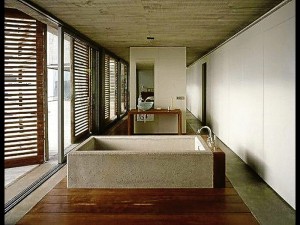Blind-sided with light and air

SHUTTERS give this modern bathroom some privacy and warmth without comprising its contemporary feel.
Long gone are the days of heavy, swagged drapery, of tassles and of cords. At least for most, our evolving preferences cleave to a world going clean and more modern in terms of design. Our weather and pollution have forced us to come leaner with our furnishings, and costs are better placed elsewhere instead of yards and yards of fabric. Life today, as we know it, has changed the way we dress our windows.
We can thank the Classic Revival period of the mid 1800s, its monumental architecture and use of tall, wide openings (spurred by the advent of sheet glass) for promoting the use of door and window coverings in the Western world. More light and more exposure harked the need for some form of shading and privacy.
These large openings grew out from the small windows that once punctured the fortified walls of the Dark Ages, slowly enlarging as the peaceful and open-minded Renaissance flourished and promoted exposing the indoors to the outdoors, allowing more light—and view—into one’s abode. This is not to say that window coverings did not exist prior to that. In the Orient, the civilizations of India, Persia China and Assyria crafted richly decorated textiles into door and window covers long before the West did.
Window shutters
Today’s modern windows are quite the opposite of the Medieval Ages’. The ratio of solid to opening—wall to window—has reversed. The modern world’s curtain-wall system has virtually replaced our walls with windows. But our wish to bring more light in and see more of the outside (and be part of it!) has also brought upon us, a myriad of concerns relating to exposure, visibility, too much sunlight and too much heat. With window-related issues having grown a hundredfold, so too possibly, have the solutions. But one ancient and eternal favorite remains: the window shutter.
Today’s wooden shutters were modeled from its ancestor, the fixed marble shutters, which were first used in Greece. It was a common device that flourished throughout the Mediterranean in its more affordable and workable timber form.
Later, movable shutters that were fixed to a frame became more popular as they allowed each panel to be swung open, or tilted to control the ingress of light and air. This window system eventually became the norm in Europe, especially for those who could not afford the upper-crust’s more contemporary glass windows. The Spaniards later brought shutters to the New World, just as France and Britain brought it to the East and West Indies and to many of its colonies, thence, the popular “plantation shutters.”
Shutters give windows a resort-like character. When colored in white, they effectively deflect light without killing it. They exude a stately elegance, even in a casual atmosphere. They bring us back to the colonial times of gracious estates and men in white suits. In darker, natural stains of wood, they suggest the tranquility of a bedroom, the melancholy of a man’s cigar club, the stateliness of a New England library and the equilibrated living space of an Asian resort villa. In all applications, they generate an utmost sense of warmth.
The same can be said for wooden blinds, which have thinner and longer blades, and are hung from strings or straps that can be adjusted. With an attached rod rotated, the blades can be tilted or made flat against each other in order to block light, much like the shutter. They can also be used in wider openings for the blades are supported at certain intervals of its width.
Blinds and shutters are not limited to windows, as they are made even more effective when framed into doors and can completely open up spaces.
Venetian blinds
Modern times ushered in the use of aluminum blinds, now more popularly know as “venetian blinds.” Their blades range from a width of two inches to a narrow three-fourths of an inch.
These days, they are simple referred to as “blinds” or “aluminum blinds” and are possibly the most inexpensive and maintenance-free window treatment. The downside is that they are quite casual and spartan, and if you’d like a slightly more extravagant look, this is not for you to use. Some imported and prefabricated window systems integrate blinds into their double-glazed panels, so that they are insulated from dirt, and yet can be controlled by an external mechanism.
In the tropics where we are, sunshine-friendly blinds and louvers seem to work best: they can move with your preferred light level and degree of exposure to the outside. Moreover, they harbor minimal dust, are almost mite-free, and are easy to maintain and durable.
Heavy and complicated drapery can look gorgeous in the right setting, but that setting—elaborate, heavy and flamboyant—is beginning to fade-away into a bygone lifestyle.

